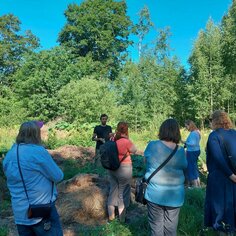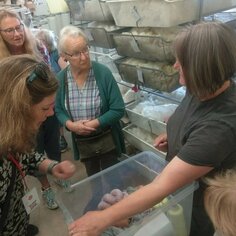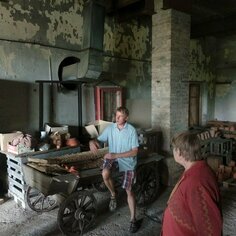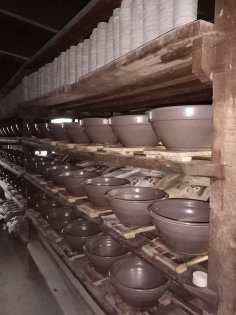Field trips
On the field trip day, all participants have a chance to visit one area with distinct heritage culture. This year, two coffee breaks and lunch are included in all the trip fees. If you wish to have a day off, wander around in Viljandi or surroundings, you can choose not to participate in the field trip offered by the organizers of the camp. However, the field trips include visiting small enterprises, local craftsmen and rural places which are not always open for tourists to visit.
Tip! If viewing the descriptions of field trips, click on the photos in order to see them in full size.
Peipsiveere (meaning "the shores of the Peipsi lake") refers to the culturally rich area surrounding Estonia's largest lake. This region is renowned for its Old Believer communities, traditional crafts, and unique culinary heritage, such as smoked fish and onion farming.
SCHEDULE:

8:20-10.00 Viljandi-Varnja
10.00-11.00 Visit to the Varnja Living History Museum
The museum's exhibition provides an overview of the lifestyle of the Russian Old Believers from the late 19th century to the early 20th century.
Coffee break
11.00-11:30 Bus tour with a guide in the Old Believers' villages of Varnja-Kasepää-Kolkja.
11:30-12:15 Visit to the Peipsimaa Heritage Center.

The center focuses on preserving and developing the traditional handicraft skills of the Peipsimaa region. https://www.peipsimaa.ee/et
12:15-13:00 Lunch at the Peipsimaa Heritage Center
13:00-14:00 Talisman doll-making workshop at the Peipsimaa Heritage Center.
350 m stroll
14:15-15:45 Introduction to the history of the pryanik tradition, pryanik tasting, and a decorating workshop + coffee break at the Peipsimaa Pryanik Farm https://www.sibulatee.ee/liikmed/peipsimaa-praanikutalu/
Kolkja-Altskivi
16:00-17:30 Visit to the Alatskivi Castle https://www.alatskiviloss.ee/
17:30-19:00 Alatskivi-Viljandi

Soomaa, meaning "Land of Bogs," is a unique wilderness area in southwestern Estonia, renowned for its vast wetlands and rich biodiversity. It is best known for the "fifth season," a period of seasonal flooding when rivers overflow, turning the landscape into a waterway.
SCHEDULE:
8:20-9:00 Viljandi-Tipu
9:00-10:00 Tipu Nature School:
Introduction to the yard and old schoolhouse, including rural skills, clay construction, herbal tea tasting, and plant identification. There are farm animals on-site. Activities also include scything demonstrations. https://www.tipulooduskool.ee/en
Coffee break
10:00-10:30 Tipu-Levi
10:30-12:00 Levikivi Stonemasonry:
A visit to the stonemasonry and a small workshop where participants can create stone keychains or simple necklaces with optional decoration. https://www.levikivi.ee/en-levikivi.html
12:00-12:15 Levi - Tohera, Saarisoo talu
12:15-13:00 Lunch at Juta Pertel's

13:00-14:00 Introduction to Tori National Costumes by Juta Pertel
14:00:15:30 Ribbon Weaving Workshop with Juta Pertel
15:30-16:30 Introduction to Haabja Canoes (and General Overview of Soomaa) with Aivar Ruukel
16:30-18:00 Canoeing Across the Navesti River, Hike and Swimming in Riisa Bog + snack break, led by Indrek Vainu
18:00-18:45 Riisa õpperaja parkla - Viljandi

Võromaa, a southeastern Estonian region, is renowned for its unique Võro language and rich cultural heritage. Locals cherish their traditions, from ancient songs and dances to handcrafted wooden carvings and woven textiles.
SCHEDULE:
8:00-9:00 Viljandi-Lapetkume village
9:00-10:00 Visit to the Muru Wool Factory
A small, modern wool factory with combing technology, where you can have wool from your own animals made into wool, combed tape and various yarns, or buy ready-made products. https://villavabrikmv.ee/en/
10.00-11.00 Lapetkume village-Võru

11.00-12.30 Introduction to Võru National Costumes by Vilve Oja and an introduction of Old Võru County by Külli Eichenbaum in Vana-Võromaa Ideekoda https://www.ideekoda.ee/loovmeistrid/vana-voromaa-kasituu-mtu/
12.30-12.45 A stroll to NAMM restorani
12.45-13.45 Lunch at NAMM restoran
13.45-14.15 Võru-Süvahavva
14.15-15.15 Visit to the Süvahavva Nature Farm
A tour of the herb garden – in the farmyard garden, visitors can learn about tea and culinary herbs and their uses in everyday life. https://syvahavva.ee/
15.15-16.15 Süvahavva-Tsooru

16.15-17.45 Visit to the Tsooru Pottery Factory
The only company in the world that produces traditional Seto pottery made of clay. All products are crafted from high-quality clay mined in Southern Estonia.
17.45-19.15 Tsooru-Viljandi
Kihnu, a small island in the Baltic Sea, is a UNESCO-listed cultural space known for preserving its unique traditions and way of life. The island is famous for its vibrant folk costumes, traditional dances, and the central role of women in maintaining its cultural heritage.
SCHEDULE:
6:10-8:30 Viljandi-Munalaid harbour

8:30-9:35 1hr:05 min ferry ride with "Kihnu Virve" from Munalaid to Kihnu.
9:35-10:00 A walk to the Kihnu map. Introduction to the island. Transportation arrives.
Coffee break
10:00-10:10 Ride from Harbor to Lohu household with an open truck.
10:10-10:30 Visit to Lohu craft store, where the hosts sell their winter handicrafts in a small homeyard cafe/shop.
10:30-10:40 Truckride Lohu-Kihnu Lighthouse
10:40-11:10 Visit to the Kihnu Lighthouse with the opportunity to climb to the top. https://www.kultuuriruum.ee/en/tuletorn-eng/
11:10-11:25 Lighthouse-church
11:25-11:40 Visit to the church

11:40-12:50 Visit to the Kihnu Museum and a tour of the large exhibits shed located in the museum courtyard. https://kihnumuuseum.ee/
12:50-13:00 Museum-Rannametsa household
13:00-13:45 Lunch at Rannametsa household.
This household accommodates three generations of one fishermans family. Your lunch consists of a fish soup from an early morning catch, continued by freshly smoked fish straight from the oven and touched up by coffe, local traditional whitebread and homemade seasonal jam as dessert.
13:45-14:00 An introduction to the chests of the Rannametsa women.
Historycally familys used to keep their textile and drystore supplies in a well ventilated shed that was an important part of a traditional houshold ensemble in Estonia. Kihnu women are know to keep this tradition alive and each women on the island still has it own chest to keep all their treasures in.
14:00-14:15 Visit to the Kihnu Kaubamaja village store located at Urga household.
This store offers you anything from local crafts to a variety of textile supplies. https://kihnukaubamaja.com/

14.30-15.00 Kihnu traditional dance workshop
15.00-15.45 Three Friends: “Kihnu Kalur, Sadama Guesthouse, and Kihnu Craft” – a look at how we truly operate on this small island.
The hostess introduces the collaboration of these three businesses under one roof.
15.45-15.55 A short walk (500m) to the harbor, stops at the Njäputüe shop and at the harbor market.
16.15-17.20 Kihnu-Munalaid
17.20-19.30 Munalaid harbor-Viljandi



